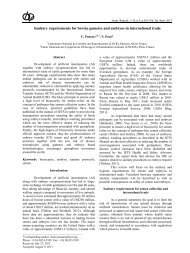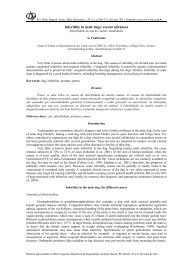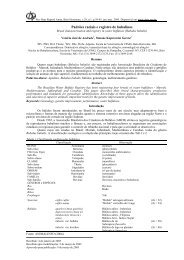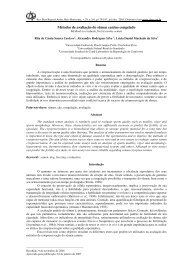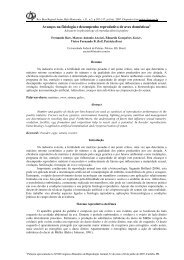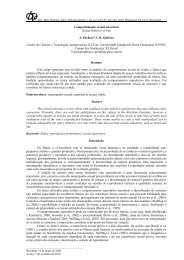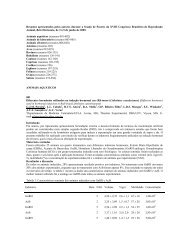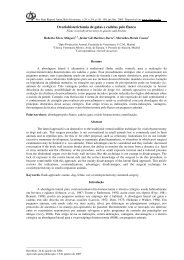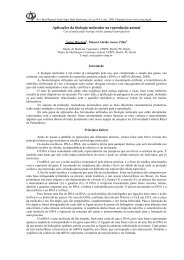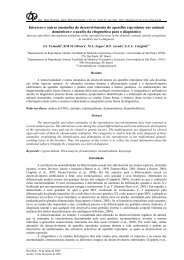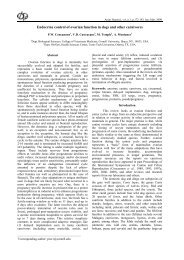Recent advances in ovulation synchronization and superovulation in ...
Recent advances in ovulation synchronization and superovulation in ...
Recent advances in ovulation synchronization and superovulation in ...
You also want an ePaper? Increase the reach of your titles
YUMPU automatically turns print PDFs into web optimized ePapers that Google loves.
Abstracts. II International Symposium on Animal Biology of Reproduction, Nov. 19-22, 2008, São Paulo, SP, Brazil.<br />
Dom<strong>in</strong>ant follicle growth is <strong>in</strong>terrupted by <strong>in</strong>trafollicular <strong>in</strong>jection of FGF10 <strong>in</strong> cattle<br />
B.G. Gasper<strong>in</strong> 1 , M.T. Rovani 1 , R. Ferreira 1 , J.F.C. Oliveira 1 , J. Burat<strong>in</strong>i Jr 2 , C.A. Price 3 , P.B.D. Gonçalves 1<br />
1 Laboratory of Biotechnology <strong>and</strong> Animal Reproduction, Federal University of Santa Maria, RS, Brazil; 2 Department of<br />
Physiology, Institute of Biosciences, Sao Paulo State University, Botucatu, SP, Brazil; 3 Centre de Recherche en Reproduction<br />
Animale, Université de Montréal, Québec, Canada.<br />
Introduction<br />
Fibroblast growth factor 10 (FGF10) is expressed by oocytes <strong>and</strong> theca cells from bov<strong>in</strong>e antral follicles, <strong>and</strong> its<br />
expression is negatively correlated with estradiol levels <strong>in</strong> the follicular fluid (1). FGF10 receptor (FGFR2IIIB) is<br />
expressed by mural <strong>and</strong> cumulus granulosa cells (1,2) <strong>and</strong> corpus luteum (3). When added to granulosa cells culture,<br />
FGF10 decreases estradiol secretion (1) <strong>and</strong> expression of angiotens<strong>in</strong> II receptor type 2 (AT2; 4). Thus, the aim of<br />
this study was to test the hypothesis that FGF10 acts as an <strong>in</strong>hibitor of dom<strong>in</strong>ant follicle development around<br />
deviation <strong>in</strong> cattle.<br />
Materials <strong>and</strong> Methods<br />
Eighteen cows were submitted to a hormonal protocol <strong>in</strong> order to <strong>in</strong>duce a new follicular wave. Ovaries were daily<br />
monitored <strong>and</strong> when the largest follicle reached the diameter of 7-8 mm, it was <strong>in</strong>jected PBS (Control group; n = 3)<br />
or human recomb<strong>in</strong>ant FGF10 at 100 ng/mL (FGF100 group; n = 4) or at 1,000ng/mL (FGF1,000 group; n = 3). The<br />
<strong>in</strong>jected amount was calculated based on the volume of follicular fluid estimated by a l<strong>in</strong>ear regression equation (5),<br />
to obta<strong>in</strong> an adequate f<strong>in</strong>al concentration <strong>in</strong>side the follicle. After the <strong>in</strong>jections, animals were daily monitored by<br />
ultrasound dur<strong>in</strong>g three days to evaluate effects on the follicular dynamics.<br />
Results <strong>and</strong> Discussion<br />
The <strong>in</strong>trafollicular <strong>in</strong>jection of FGF10 at 100 or 1,000ng/mL <strong>in</strong>terrupted follicular growth compared to control group<br />
(Fig. 1). FGF10 was shown to be downregulated <strong>in</strong> theca cells of healthy steroidogenic follicles <strong>and</strong> to decrease<br />
estradiol production of cultured granulosa cells without affect<strong>in</strong>g cell proliferation (1). <strong>Recent</strong>ly, our group<br />
demonstrated that angiotens<strong>in</strong> II signal<strong>in</strong>g is necessary for the cont<strong>in</strong>uation of follicular growth near follicle<br />
deviation (6), <strong>and</strong> that the expression of AT2 receptors is <strong>in</strong>hibited by FGF10 <strong>in</strong> cultured granulosa cells (4). Taken<br />
together, these results suggest that FGF10 acts as an important regulator of follicular growth <strong>in</strong> cattle. We propose<br />
that FGF10 expression needs to be suppressed <strong>in</strong> order to allow the cont<strong>in</strong>uation of follicle growth after deviation.<br />
FOLLICULAR SIZE (mm)<br />
14,0<br />
13,0<br />
12,0<br />
11,0<br />
10,0<br />
9,0<br />
8,0<br />
7,0<br />
6,0<br />
5,0<br />
4,0<br />
Day: p=0.1<br />
Group: p



